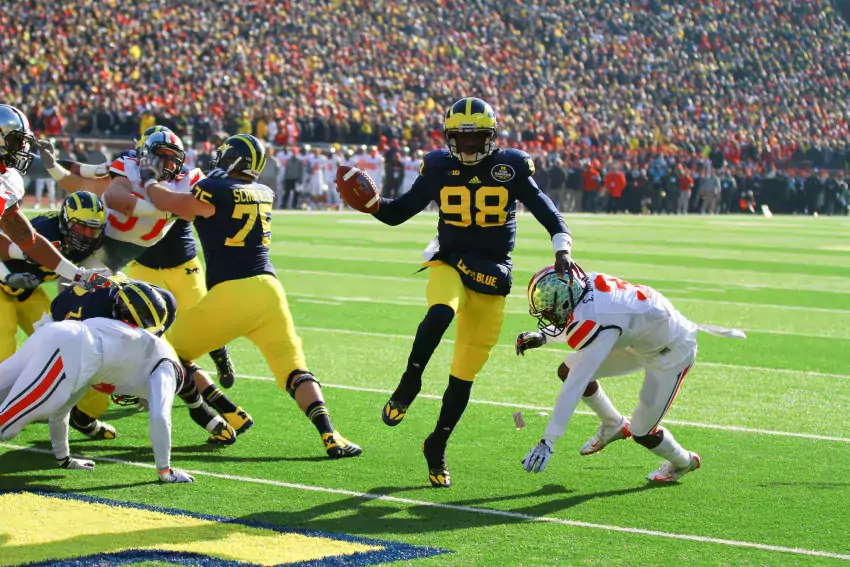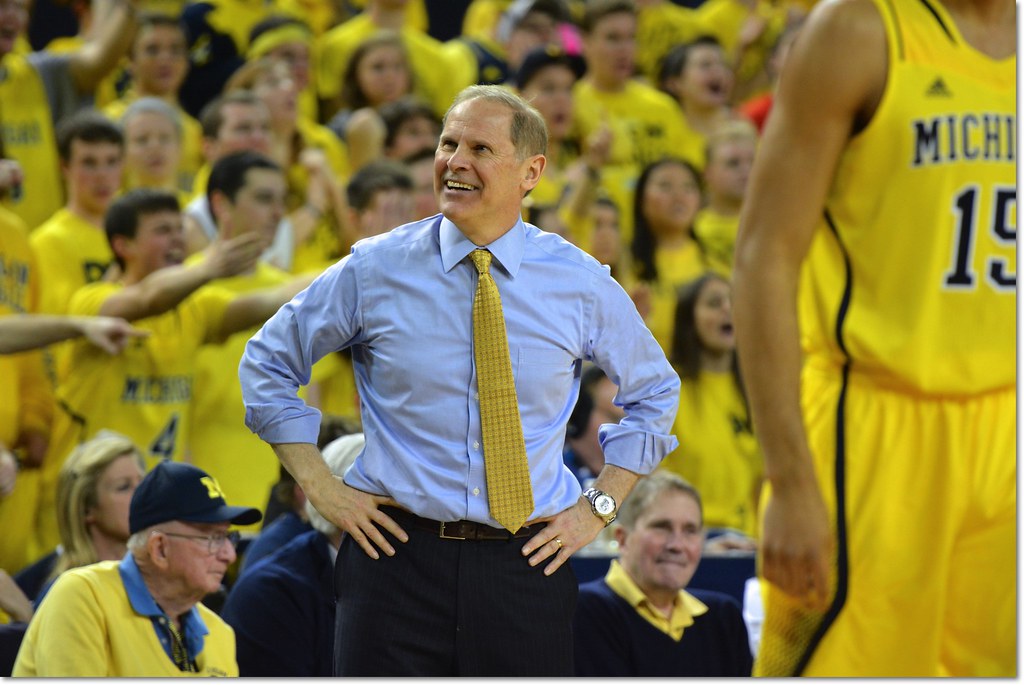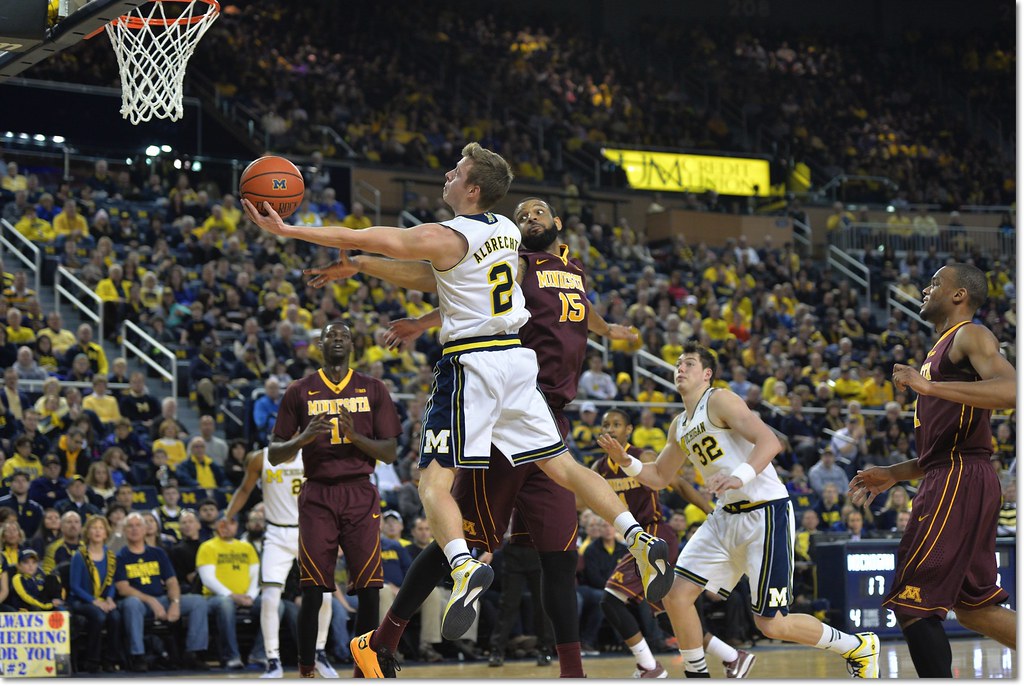evan smotrycz

The gap.
Biggest gap for a Michigan athlete between their potential and their reality during their time at Michigan?
— Matthew Cheney (@matthewdcheney) March 17, 2021
This is a fascinating question. I'm going to leave out guys who saw their careers derailed by injury (Antonio Bass, Tarik Black) and also guys who the recruiting industry airballed on (Kevin Grady, Derrick Green) and limit this folks who clearly had something to offer and did not get to display it for whatever reason:
- Devin Gardner. Gardner looked like a Heisman contender at certain points (ND UTL II, the two point conversion game against OSU) and was battered to pulp by the worst pass protection of all time at all other points. Not too hard to see him in the NFL if he hadn't ascended to nirvana in the middle of an MSU game.
- Ernest Shazor. Electric hitter, five star recruit, repeatedly ran the wrong way at incredible rates of speed. He must have had some personal issues because he went from a projected second-round pick to completely undraftable in a couple months in which no football was being played.
- Donovan Peoples-Jones. Five star wide receiver with massive athletic talent who saw his QB exit the pocket repeatedly and avoid downfield shots even when they were blitheringly wide open. Might as well file Nico "60 targets" Collins in here too.
- Denard Robinson. Had just established himself as the most electric player in college football when Brady Hoke came in and brought in a guy who wanted to put him under center. Nerve injury had a lot to do with his late-career fade, too, but seeing Denard run a waggle will remain a crime against man and panda forever.
- Evan Smotrycz. Smotrycz was coming off a 53/44 shooting year and was a career 41% three point shooter on ~200 attempts when he decided to transfer to Maryland. A major reason for this was the fact that he got drafted into playing a bunch of center, which he openly loathed. He ended up being redundant with Jake Layman at Maryland and faded into being a bench player as a senior. There's an alternate Smotrycz history where he gets to be a stretch four under Beilein for four years and has an absurdly efficient statline as an upperclassman.
Protests?
Given the timing of #NotNCAAProperty do you think it's likely there will be an on court protest during the tournament?
— Mathew Puskar (@NoExtraT) March 18, 2021
That's impossible to project but I do feel like that day is coming closer every year. Getting garbage meals while quarantined in a hotel so that everyone except you gets paid buckets of cash does seem like a potential tipping point. At some point a team is going to realize that they have a considerable
I've advocated for teams to adopt a mini-boycott where they don't play for 15 minutes—and if the network cuts to commercial the counter starts over. That would be a wake-up call that could escalate if necessary.
[After THE JUMP: ravoli rebels]

Previously: Part One
After looking at Michigan's stellar pick-and-roll production and how they do it last week, I dove deeper into Synergy's database to try to put this year's team in a historical context. At first I was just looking at other lead ballhandlers, then I was putting tables for every season together, then I realized I needed to add the screeners to the equation and look at how each team varied their P&R attack to do this right.
So what was going to be the second half of this series is now the second of either three or four parts. I'm trying not to make these too long to digest. These posts are going to be heavy on Synergy's stats, so I want to make a few notes before going any further.
While Synergy uses the terminology "points per possession" to describe how they measure production, that's very misleading when you're used to looking at KenPom. I'm switching over to describing Synergy stats as "points per play." The distinction is described in this useful Cleaning The Glass post:
CTG distinguishes between possessions and plays, and this distinction is important when diving into context information. A possession starts when a team gets the ball and ends when they lose it. A play ends when the team attempts a shot, goes to the foul line, or turns the ball over. If a team gets an offensive rebound, that results in a continuation of a possession but a new play. So a possession can have multiple plays.
Play contexts are per-play, not per-possession. For example, a team might come down in transition and miss a shot, get the offensive rebound, kick it out, and run a halfcourt set. Then might miss that shot but get a tip in to score and end the possession. That was all one possession, but three different plays and three different contexts: the first shot was in transition, the second in the halfcourt, and the third was a putback.
Because offensive rebounds start a new "play" within a possession, points per play are inherently going to be lower than points per possession. To help contextualize, I've included each player's national percentile rank for that season along with their stats.
For ballhandlers, "own offense" includes plays that finish with a field goal attempt, shooting foul, or turnover. "Passes" measure the result of shots that come as a direct result of the ballhandler's pass out of the pick-and-roll. "Keep percentage" is a stat I added myself that simply measures the percentage of a time the ballhandler uses his own offense instead of recording a passing play—Michigan has had players arrive at similar efficiency despite sporting very different styles.
an enjoyable pick-and-pop example
For screeners, you mostly just need to know the difference between popping, rolling, and slipping a screen:
- Popping: setting the screen and then stepping out (usually to the three-point line) for what's almost always a spot-up shot. Occasionally a more versatile big man will drive off a pop. Think Moe Wagner.
- Rolling: setting the screen and then going to the basket in the hopes of getting a layup/dunk. Think Jordan Morgan.
- Slipping: faking the screen before running to a predesignated spot—usually the rim, sometimes spotting up if it's a Wagner-type or perimeter player—as a changeup to keep defenses from overplaying the ballhandler.
As a general rule, points per play are going to higher when the screener finishes the play than the ballhander because of the nature of the pick-and-roll. A pass is usually going to be thrown to an open man when the play works; while the ballhandler could take a shot because he got open himself, he also usually has to finish the play if it's well defended.
Consider the degree of difficulty of Zavier Simpson's or Cassius Winston's shots; it's hard to be a really efficient scorer off the pick-and-roll. Morgan, while a great roll man, often just had to catch the ball and finish an uncontested shot at the rim. Most of Wagner's pick-and-pop threes went up without a real shot contest. This makes sense: there's little reason to pass the ball to your big man if he isn't open. Teams also often default to a quick screen in late clock situations, which tends to create more difficult shots the ballhandler has little choice but to take.
The other thing to note in the screener stats: under number of plays in each category, "%" shows the percentage of the time each player popped, rolled, or slipped out of their overall screener plays used. The "%ile" under points points play in each category, however, measures percentile national rank. I realize this is a little confusing but I couldn't come up with a better way than Synergy in this case.
With that out of the way, let's dive in.
[Hit THE JUMP for a year-by-year history of Michigan's pick-and-roll offense and what we can learn from it.]

[Bryan Fuller]
John Beilein has spent ten seasons in Ann Arbor. As of the most recent, he's the winningest coach in program history with 215. He snapped Michigan's post-sanction tournament drought in 2009, the first of seven NCAA appearances with the Wolverines, three of which have extended at least into the second weekend.
In recognition of the above, as well as the need for offseason #content, I've put together a series of All-Beilein teams, inspired by this twitter post and the ensuing conversation. My guidelines:
- I'm attempting to put together the best possible lineups, which isn't necessarily the same as picking the best individual players at each spot.
- I'm choosing individual player vintages (i.e. 2013 Trey Burke). A player can only be chosen once for each category, but different player years (i.e. freshman bench gunner 2014 Zak Irvin and well-rounded senior 2017 Zak Irvin) can be eligible for separate categories.
- Eligibility for certain categories, like today's best bench players, may be slightly fudged because of the limited pool of players.
I'm not putting too many constraints on myself for this exercise since the point is to let our imaginations run wild. Without further ado, here's the first All-Beilein team, which wasn't easy to put together given Beilein's tendency to roll with a tight rotation: the All-Bench squad.
POINT GUARD: 2014-15 SPIKE ALBRECHT

The YMCA Scoop. [Fuller]
We start with the fudged guidelines right away, as Albrecht ended up starting 18 games in this particular season because of Derrick Walton's foot injury. This was the best version of Spike, however, and any of the previous versions would also have earned this spot; between injuries, early draft departures, and the occasional recruiting miss, depth at the point has been hard to come by in the Beilein era.
For the better part of four years, Spike was the exception to that rule. He was an excellent passer. He covered for being undersized by displaying a knack for jumping passing lanes. He did donuts in the lane. He broke out the old-man scoop for critical layups. Most importantly to Beilein's offense, he had defense-extending range and the confidence to hit big shots, after which he just might do the Sam Cassell big balls dance:

Spike was a 41% three-point shooter at Michigan. While he probably would've earned this spot based on one particular half of basketball alone, he did a whole lot more than just light up Louisville.
Honorable Mention: 2008-09 CJ Lee. Another player whose selection is borderline cheating since Lee finished the season as the starter, but he came off the bench in twice as many games as he started as Beilein searched for the right guy between football-player-turned-scholarship-point Kelvin Grady and two walk-ons, Lee and David Merritt. Lee eventually won out by being the most reliable offensive player and best defender.
[Hit THE JUMP.]
72